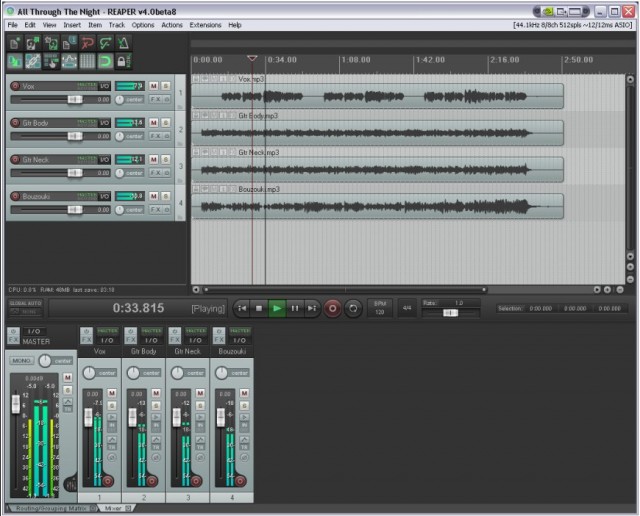In DAWs, there are the familiar names – MOTU DP, Pro Tools, SONAR, Ableton Live, Cubase, Apple Logic. All have functionality to recommend them – hence their longevity. But then, there’s one upstart that continues to win over fans: Reaper. Its developers actually advertise that its upgrades are evolutionary, not revolutionary – which may come as a comfort to pro users easily jangled by radical UI changes.
But evolutionary as it may be, Reaper 4 has some highlights I think could significantly broaden its appeal. The changelog is utterly, terrifyingly long, so let me pull out some of the big points. (See also the preview we ran in December.)
A new, customizable user interface. Various DAWs keep trying this, but Reaper has a nice take: easily drag and float or dock windows and toolbars, then customize navigating them with mouse modifiers. There’s also the ability to make your own layouts.
Multichannel and surround. Multichannel track metering, plus a 3D panning ReaSurround plug-in with “rotations, transformations, and diffusions,” make this a serious offering for people working with multichannel diffusions. (Incidentally, that appears to look nice enough for people doing configurations other than conventional surround, too.)
Improved STEREOPHONIC SOUND. Okay, so you’re not quite ready for this 3D speaker diffusion surround business? There’s still some goodness for you. Track pan improvements give you additional control over stereo width – and you can even set stereo width to envelopes for some serious headphone ear candy. You can also set track pan to one of several modes: “balance, stereo pan (L/R + width), dual pan, and classic (3.x) balance.”
Batch capabilities. New batch conversion and rendering options let you easily send batches to folders and files, and use customizable wildcards for more control. You can also save render presets. Translation: people working on complex projects like games are going to love this. (I wonder if the collaboration with Rock Band developer Harmonix might bear fruit here.)
A Project Bay collects media and effects and lets you organize lists of assets for different projects. The Project Bay also manages comps directly – usually comps, multiple takes, are handled only within tracks; seeing them in project management is an interesting new idea. These things you really have to try out in practice over some big projects, but I’m encouraged by the addition.
MIDI musical manipulation: Interestingly, the project management magic also includes the ability to pool and edit and share MIDI data, which is something I’ve never seen before. I imagine you could develop some elaborate compositional workflow based on this, with patterns you modify all at once for … generative techno? Micro-edited ambient? You figure it out! There are also new MIDI constrain features that let you create MIDI patterns based on chords or scales. For the first time, Reaper is looking like a contender as a tool for imagining new musical ideas with MIDI.
Envelope editing lets you customize envelope segments with the mouse. New pitch shift envelopes let you mangle and modify the pitch of sounds.
Did we mention that Reaper costs as little as US$60 for a non-commercial license, and with that or the $225 license, you get upgrades through Reaper 5.99? Mac + Windows (+ Linux, via WINE).
Check out the full, new feature set:
Reaper 4 Changelog
Version 4.0 discussion at the forums
http://reaper.fm/
Thanks to Jeffrey James and everyone who sent this in!
